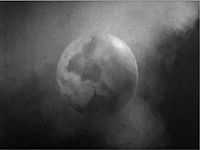Mondas
| Mondas | |
|---|---|
|
Mondas as it appeared in The Tenth Planet[1] | |
| Universe | Whoniverse |
| Notable races | Cybermen |
| Genre | Science fiction television |
Mondas is a fictional planet in the British science fiction television series Doctor Who. Mondas is the homeworld of the Cybermen, a race of cyborgs.
Mondas is first mentioned in the 1966 Doctor Who serial The Tenth Planet. This episode is also the first appearance of the Cybermen, a race that recurs in numerous Doctor Who stories. In The Tenth Planet, a New Zealand astronaut discovers a newly arrived planet near Earth, between the orbits of Mars and Venus. Later, a Cyberman informs the personnel of a nearby space station that this planet is the home of his people, the Mondasians. When the Cyberman mentions the planet's name, a Doctor Barclay inquires whether Mondas is not an ancient name for Earth (c.f. the Latin mundus). The Cyberman confirms, and claims that, billions of years ago, Mondas and Earth were twin planets until Mondas drifted into deep space.[1] (In the mock-historical section of his book Cybermen, David Banks suggests that the Moon's orbit around Earth was the cause of Mondas' departure from orbit.)
The Cybermen began to send spaceships to conquer and colonise other planets, including Telos, where they pushed the native Cryons aside[2] and established the "tombs" of the Cybermen, vast vaults where they could take refuge in suspended animation if needed.[3]
Eventually, the Cybermen fitted a propulsion system to Mondas itself. This allowed them to pilot the planet through space, returning it to the solar system in 1986. The Cybermen invaded Earth while Mondas drew closer, draining Earth's energy to replace and supplement its own. However, the energy absorbed was too much, and Mondas disintegrated along with the Cyber forces on Earth.[1]
The 2006 episodes "Rise of the Cybermen" and "The Age of Steel" introduce Cybermen who originated from an Earth in a parallel universe, rather than on Mondas.[4][5] The Tenth Doctor alludes to Mondas when he explains that the Cybermen of his own universe started from a planet "just like" the Earth.[5]
Other appearances
The comic strip The World Shapers, written by Grant Morrison and illustrated by John Ridgway and Tim Perkins, (Doctor Who Magazine no. 127–129) shows the Voord of the planet Marinus using stolen time technology to "quick-evolve" themselves into the earliest Cybermen, which would make Marinus an earlier version of Mondas, before a change of name.[6]
Incompatible with this explanation, the Virgin Missing Adventures novel State of Change by Christopher Bulis takes place on Terra Nova, a duplicate of Earth which may possibly later turn into Mondas.[7]
The monthly series of comic strips written by Alan Barnes and drawn by Adrian Salmon, The Cybermen (DWM no. 215–238) ignored this and takes place on an unspoiled version of Mondas. It is not an origin story per se, but a sequence of events taking place in a larger history beginning with the story The Dead Heart, taking place some time after Mondas has begun its journey. It shows Cybermen similar to those shown in The Tenth Planet discovering and warring with Silurians and Sea Devils.[8]
The last story of the cycle, The Ugly Underneath, depicts the original Cybermen having died out, by which time an Earth-like, technologically modern civilisation has arisen to replace them. The comic strip ends with the implication that revived Cybermen will, one day, still take over the planet. The Sea Devils and Silurians do not appear in this story.[9]
In the Big Finish Productions audio play Spare Parts, the Fifth Doctor and his companion Nyssa arrive on Mondas prior to the rise of the Cybermen, while it is still drifting through space. There, they discover the Mondasians living underground in a culture virtually identical to that of England in the 1950s, although with more advanced technology. The play relates the slow slide of the Mondasians towards cyber-conversion, conceived by the cybernetic gestalt intelligence controlling Mondas (an early version of the Cyber Planner seen in The Wheel in Space and The Invasion) as a solution to the planet's increasingly desperate situation.[10]
Like for the other spin-off media, the canonicity of these and other non-televised accounts is uncertain.
References
- ↑ 1.0 1.1 1.2 Pedler, Kit; Davis, Gerry (writers); Martinus, Derek (director) (8 October 1966 – 29 October 1966). The Tenth Planet. Doctor Who. BBC. BBC1. Check date values in:
|date=(help) - ↑ Moore, Paula (writer); Robinson, Matthew (director) (5 January 1985 – 12 January 1985). Attack of the Cybermen. Doctor Who. BBC. BBC1. Check date values in:
|date=(help) - ↑ Pedler, Kit; Davis, Gerry (writers); Barry, Morris (director) (2 September 1967 – 23 September 1967). The Tomb of the Cybermen. Doctor Who. BBC. BBC1. Check date values in:
|date=(help) - ↑ MacRae, Tom (writer); Harper, Graeme (director) (13 May 2006). "Rise of the Cybermen". Doctor Who. Series 2. Episode 5. BBC. BBC One.
- ↑ 5.0 5.1 MacRae, Tom (writer); Harper, Graeme (director) (20 May 2006). "The Age of Steel". Doctor Who. Series 2. Episode 6. BBC. BBC One.
- ↑ Morrison, Grant (w), Ridgway, John (p), Perkins, Tim (i). "The World Shapers" Doctor Who Magazine Issues 127–129 (August 1987–October 1987), Marvel UK
- ↑ Bulis, Christopher (December 1994). State of Change. Virgin Missing Adventures. Virgin Books. ISBN 0 426 20431 X.
- ↑ Barnes, Alan (w), Salmon, Adrian (a). "The Cybermen: The Dead Heart" Doctor Who Magazine Issues 215–220 (3 August 1994–21 December 1994), Marvel UK
- ↑ Barnes, Alan (w), Salmon, Adrian (a). "The Cybermen: The Ugly Underneath" Doctor Who Magazine Issues 235–238 (14 February 1996–8 May 1996), Marvel UK
- ↑ Platt, Marc (writer); Russell, Gary (director) (July 2002). Spare Parts. Doctor Who: Main Range. Big Finish Productions.
External links
| ||||||||||
